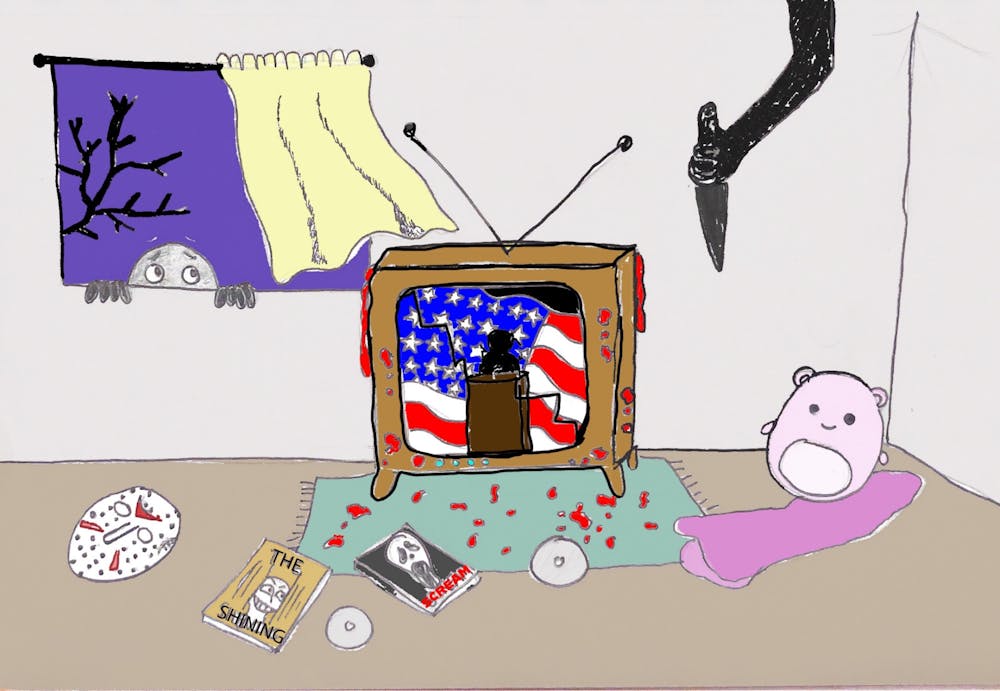It was just Halloween. The election is this week. It’s a pretty scary time to be alive. In the spirit, let’s talk about horror films.
Fear and politics have always been deeply intertwined, making the horror film a deeply political art form — though it is often written off as nothing more than cheap scares.
Over the course of the year, I’ve noticed a few trends emerge: reboots and sequels, demon horror and body horror.
Two films this year really stood out: “Longlegs” and “The Substance.”
“Longlegs” follows FBI agent Lee Harker as she attempts to solve a string of murder-suicides all committed by fathers who are influenced by a Satanic entity known as Longlegs. The murders all occurred in the six days before or after the ninth birthday of a family’s daughter.
The film’s cinematography has a moody, sickly, yellowed tone with muted colors and dark shadows, creating a menacing and confusing ambience apt for the genre.
“The Substance” follows Elisabeth Sparkle, a former Hollywood darling-turned washed-up Jazzercise instructor. Elisabeth is eventually fired from her Jazzercise show, and on her drive home, she gets into a car crash.
At the hospital, a nurse slips her a “prescription,” and advises Elisabeth to try a mysterious treatment called “The Substance,” which harvests an individual's DNA to create a “better, younger, more perfect version” of themself.
Elisabeth takes it, creating a new body and “self” named Sue. But there’s a catch: A user must spend seven days in the old body, then seven days in the new one, which can only be maintained via lumbar fluid from the old body.
Eventually, Sue takes too much fluid, using Elisabeth’s body to preserve her own — to both of their detriments.
The film is almost dizzyingly bright and colorful, from the hot pink Jazzercise set to the stark, clean bathroom the unused body is kept in.
It doesn’t look like horror, but it feels like it.
Get content from The Daily Lobo delivered to your inbox
I expected to see a lot more disease or zombie horror coming out of the COVID-19 pandemic. Films take a long time to produce, create, edit and market, especially taking into account the Screen Actors Guild and Writers Guild of America strikes.
Even if a film was written and created after 2022, things like rampant, widespread disease tend to stick in the culture consciousness. Fears stick with us.
Unless, of course, something comes around that scares us even more.
Though on the surface, it’s been a diverse year for horror in terms of aesthetic and subject matter, I cannot help but notice an emerging theme of loss of control. Now, there is a pervasive fear of something taking over your body and life — be it demons, aliens or a drug-induced replica.
Another emerging theme is deception and betrayal by theoretically “trustworthy” individuals, such as well-loved TV hosts (“Late Night with the Devil”), parents (“Longlegs”) or medical professionals (“The Substance”).
The big fear is not on the minds and screens of American audiences, nor is it on any one creature or killer. It’s a loss of freedom and control — an utter dehumanization as something bigger and more powerful than you strips you of your liberties, free will, power and eventually your life.
I wonder why that’s on so many people’s minds right now.
It’s not just that politics influences horror movies; it’s that politics and horror are influenced by the same thing: fear.
Politics lately have been a fraught landscape with very high stakes, especially when it comes to overreach of control, breach of trust, and bodily autonomy.
But what we’re scared of in films, we may take arms up against in life.
As much as horror is influenced by politics, politics can be influenced by horror.
It’s been a rough year for the United States but a great year for horror. Only time will tell what lurks in the dark and in the future.
Addison Fulton is the culture editor for the Daily Lobo. She can be reached at culture@dailylobo.com or on X @dailylobo






